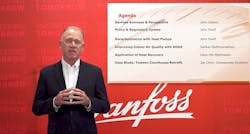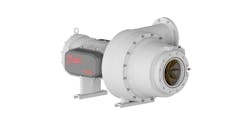Danfoss Briefing Provides Positive Forecast, Technology Updates
COMPILED FROM PRESS RELEASE AND ONLINE PRESENTATIONS
Baltimore, Md. -- Danfoss hosted its 26th annual press conference in a virtual format on February 11, as a follow-up to the 2022 AHR Expo. Danfoss executives briefed members of the media on trends facing the HVACR industry and the technologies it has developed. Heat pumps, heat recovery, dedicated outdoor air systems and the ongoing refrigerant transition were main topics, as Danfoss leadership emphasized the need for innovation and deployment of new technologies to reach decarbonization and energy efficiency goals.
John Galyen, Danfoss North America president, launched the event and expressed his hope that Danfoss would be back at the AHR Expo in person in 2023. Galyen provided an update on Danfoss’s business achievements in 2021 and a preview of the challenges ahead in 2022. With what Danfoss and others believe is an increase in attention to climate change and reducing the world's carbon footprint, Galyen emphasized the importance of energy efficient heating and cooling technologies.
“Energy efficiency is our first fuel,” Galyen said. “We have available proven and under-deployed technologies that can have significant impact in the short term, and these technologies are paving the pathway toward other future innovation. Every kilowatt saved today means a better tomorrow.”
Galyen said Danfoss is well-positioned to help customers adopt new, energy-efficient HVACR systems. noting the new technologies Danfoss has developed: heat exchangers, dedicated outdoor air systems (DOAS), more efficient heat pumps and compressors compatible with low-GWP and ultra-low GWP refrigerants. With the coming phasedown in HFC refrigerants, “Danfoss not only has the technologies,With the coming phasedown in HFC refrigerants, “Danfoss not only has the technologies, but also the knowledge and expertise to help our customers navigate this transition,” John Galyen said.
Galyen stated Danfoss’s commitment to research and development and to innovation, and reported that two Danfoss Turbocor oil-free compressors were recognized in the 2022 AHR Innovation Awards, bringing the number of Danfoss award recognitions to 33 over 18 years.
Technology to Provide Greater Efficiency
Other technology innovations he said HVACR contractors and their customers can watch for will include variable speed technology, the next generation of heat exchangers using plates and microchannels to replace older, less-efficient technologies, low-GWP refrigerant-compatible products, and heat pump technologies to combat carbonization.
"There are significant refrigerant changes coming in 2022," he continued, "and we are at a transition point. The HVAC phasedown will likely result in some initial confusion as standards are implemented, and with differences across our regions. At Danfoss, we’re not only developing low-GWP and ultra-low GWP compatible compressors, we have the knowledge and expertise to help your readers understand and navigate this transition.
"Net zero carbon emissions will require us to develop new heating technologies to support the growth in heat pumps, heat recovery and heat reuse. We have broad experience based upon work that we have done in Europe and Asia along with a portfolio of products and solutions to assist our North American customers."
Regulatory and Technology Challenges
John Sheff, Danfoss’ director of public and industry affairs, shared insights around the evolving regulatory landscape and how Danfoss is helping customers meet these new challenges, particularly in the area of decarbonization and the move toward electric heat pump technology.
"The bipartisan infrastructure bill was an historic piece of legislation, adding $580 billion in new spending for roads, tunnels and bridges over the next five years. It also provides $65 billion to upgrade the nation's electric grid."
The Build Back Better bill was stalled in March, however, as originally drafted, Sheff explained it was going to earmark $550 billion for climate-related initiatives, including direct rebates for electrification of heating equipment, which would cover most if not all of the cost to electrify residential heating systems.
Sheff reported it is very unlikely that all 50 states will have new building codes in place by January 2025 to permit the use of A2L mildly flammable refrigerants, and therefore, he said, the Environmental Protection Agency is planning for uneven rollouts of A2L adoption.
Sheff reported it is very unlikely that all 50 states will have new building codes in place by January 2025 to permit the use of A2L mildly flammable refrigerants, and therefore, he said, the Environmental Protection Agency is planning for uneven rollouts of A2L adoption. There could also be a shortfall of HFC refrigerants, as the 40 percent decrease in HFC availability is scheduled for 2024. Sheff said the EPA has agreed to revisit its HFC allocation process for 2024. Increased reclamation activities will also be taking place across the US, he said.
"In cold weather it’s very difficult to use ambient air as a heat source and heat water above 40C (104F). A hydronic system utilizing a heat pump chiller generally requires at least 45C (113F) water to operate effectively," he explained. "Air-to-water heat pumps are also 10-15% less efficient than water source heat pumps due to low ambient air temperatures."
Sheff said using other sources of heat is possible, and makes sense in terms of efficiency. These sources include using waste heat from data centers, commercial refrigeration systems or wastewater treatment plants, which could provide a steady source of heat year-round.
“In addition, these heat sources can be centralized, creating the opportunity for ‘district’ heating and cooling. Entire blocks of buildings can share resources to build incredibly efficient district energy systems. Danfoss is involved in several of those types of projects in Europe, however it is not common in the US from an infrastructure and business model and regulatory aspects."
Sheff said the US HVACR industry is moving toward a future that uses air-to-water heat pumps rather than a boiler/chiller combination.
Hans Ole Matthiesen, head of global refrigeration segment marketing at Danfoss, talked about Danfoss’ heat recovery technologies and the importance of heat reuse and recovery in reducing carbon emissions and showed demonstration cases in data centers, supermarkets and ice rinks, and Sankar Padhmanabhan, global applications expert in air conditioning at Danfoss, talked about Dedicated Outdoor Air Systems (DOAS) and how they play a vital role in improving indoor air quality and ventilation with improved efficiency by applying variable speed compressors.
The briefing also featured a recent Danfoss customer, Jae Chon, business development manager at Chesapeake Systems, discussing Chesapeake Systems' installation of a new HVAC system with a synchronized hydronic loop at the Towson, Md. courthouse, using Danfoss components.
About the Author
Terry McIver
Content Director - CB
As director of content for Contracting Business, he produces daily content and feature articles for CB's 38,000 print subscribers and many more Internet visitors. He has written hundreds, if not two or three, pieces of news, features and contractor profile articles for CB's audience of quality HVACR contractors. He can also be found covering HVACR industry events or visiting with manufacturers and contractors. He also has significant experience in trade show planning.



